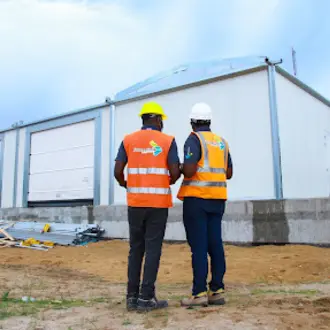Fertilizer Production & Food Self-Sufficiency in Global Growth Markets
Nadia Shalaby, PhD
Founder & CEO, Pakira, Inc.
Professional Advisor, MIT Legatum Center
Our world-wide population surpassed 8.1 billion people (UN World Population Prospects) and we all need food. Without modern agriculture, we would be experiencing food shortage for more than half of the world’s population today. Access to industrial fertilizers are directly correlated with food abundance or food shortages today.
Modern agriculture is founded on the Haber-Bosch process, which has revolutionized agriculture since it was successfully used at scale in 1913. It’s an industrial process that produces ammonia (NH3) by reacting atmospheric nitrogen (N) with hydrogen (H2) under high pressure and temperature, with the aid of a catalyst.
The chemical process is: N2 + 3H2 → 2NH3
Ammonia is the primary ingredient in fertilizers, and its large-scale use has increased agricultural crop yields globally, by 30%-50%, for nitrogen hungry staples such as corn, wheat, rice, as well as for all crops planted in nitrogen-deficient soils. Fritz Haber was awarded the Nobel Prize in Chemistry in 1918 for the synthesis of ammonia in the lab, whereas Carl Bosch received the Nobel Prize in Chemistry in 1931 for his contribution to advancing the process from the lab to industrial-scale. A back-of-the-envelope metric measures that the Haber-Bosch process is responsible for feeding half the world’s population – staggering impact!
There is one caveat. Nitrogen (ammonia-based) fertilizer production requires large industrial plants that costbillions of dollars to build. Therefore, in the first half of the 20th century, they have been traditionally constructed and operated by industrialized and wealthy countries, primarily in Europe and North America, but also in British colonial territories such as India (which included today’s Pakistan and Bangladesh.)
In the second half of the 20th century, China was undergoing a government-led policy of industrialization and agricultural self-sufficiency and modernization, thereby triggering investment in fertilizer plants at a massive scale. Mao Zedong government’s top-down policy of "walking on two legs" dictated investing in large-scale enterprises in regional centers, as well in small- and medium-scale fertilizer factories in rural areas. Nevertheless, the forcibly accelerated industrialization policy resulted in widespread famine from 1958-1962, which further emphasized the importance of fertilizers. In the 1970s, despite China’s isolationist policies during the Cultural Revolution, in order to keep up with China’s growing population, the government started importing the latest fertilizer and equipment technologies from Japan and Germany, and building more and larger plants. Early 2000s saw an inflection point in the global fertilizer market, with China emerging as the world’s largest producer (and consumer) of chemical fertilizers, especially the nitrogen-based variety.
The chemical fertilizer is $200B global market today, and it is also responsible for 2% of the global carbon emissions. Meanwhile, despite Africa’s explosive 7X population growth from 1950 to today (see chart), hardly any fertilizer production plants were built. This is evident on today’s world map colored by tiers of fertilizer production
Key fertilizer producers in the Middle East and Africa are:
- Morocco (OCP Group, which also invested $2.4 billion for a fertilizer plant in Ethiopia)
- Tunisia (eg GCT, CPG, India Fetilizer, Salakta, Tunisian Chemical, Bio Fertliizer)
- Nigeria (Dangote Group invested $2.5 billion for a new plant in Lagos; Notore Chemical)
- Angola (Amufest SA invested $2 billion for 4,000 metric ton capacity)
- Egypt reached export levels by increasing its production to increased its nitrogen fertilizer production to 3.5 M tons (Abu Qir, EFC, MOPCO, HFC, EverGrow, Alexandria Fertilizers, El Nasr Co, Ferchem Misr, Delta Agrochemicals, Bionic)
- South Africa (Nortox, Foskor, Kynoch, Gavilon SA)
- Jordan (MCFG)
- Saudi Arabia (SABIC, Maaden Phosphate Co, ARASCO, Al-Asmida, Saf Sulphur Co, Al-Bayroni, Al-Tayseer)
Over the last five years there has been significant investment around $10B in the region to build larger fertilizer plants and boost production, leading some countries, such as Egypt, to become a key exporter. However, on the scale of the region as whole, its production levels fall short by 4X to accommodate the agricultural crops required for its population. The table shows that despite the fact that Africa and the Middle East comprise nearly 21% of the world’s population, they are responsible for less than 4% of fertilizer production.
So how does Africa sustain its agriculture? The answer is that it is not sustainable.
- Buy imported chemical fertilizers, which dramatically increases the farmer’s cost, reduces profit, and increases the cost of food.
- Forego using chemical fertilizers and suffer from significantly lower yields, lower productivity of labor, high risks of seasonal fluctuations, loss of crop, and much lower profits.
As Saudi Arabia and Egypt increase their annual fertilizer production annually over the last 8 years, Africa overall has increased been increasing its import volume annually.
What if Africa is able to increase its fertilizer production without the massive capital expenditures required to build these large fertilizer production plants? Science and Technology to the rescue! It is now progressively possible to manufacture fertilizer, protect crops from pesticides, and do it at a fraction of the cost!
In other words, is it possible to make agriculture in Africa sustainable, and achieve fertilizer production and consumption parity? That is the mission! Read “Deep Techy Mighty Microbes for Africa” next.
Related Posts



